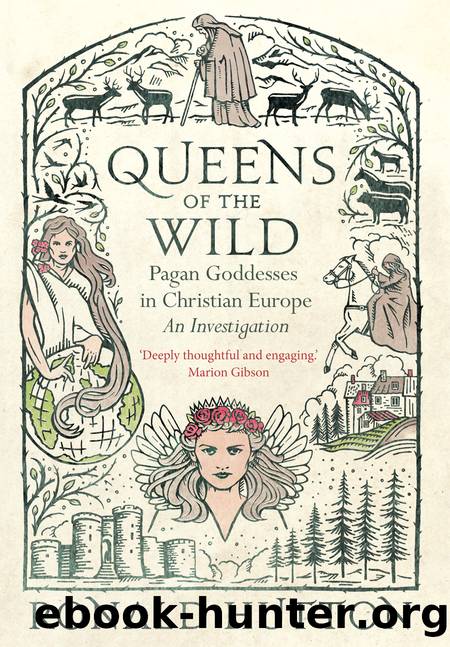Queens of the Wild: Pagan Goddesses in Christian Europe: An Investigation by Ronald Hutton

Author:Ronald Hutton [Hutton, Ronald]
Language: eng
Format: epub
Tags: History, Europe, Great Britain, Middle Ages (449-1066), Norman Conquest to Late Medieval (1066-1485), Religion, Paganism & Neo-Paganism
ISBN: 9780300265279
Google: 8DNuEAAAQBAJ
Publisher: YaleUP
Published: 2022-05-31T20:31:17+00:00
Origins
Until the present time, reasonably enough, those who have studied the medieval European night-riding tradition have assumed that it must have come down from pagan antiquity, and that the female leader must have once been a goddess.58 There has, however, been little systematic attempt made by any to find one, or a set of them, honoured across a great expanse of western and central Europe in ancient times who could have retained the loyalty of enough people to generate the medieval myth.59 The candidature of Diana has already been considered above, and the difficulties with it pointed out. Another classical Mediterranean goddess proposed for the role has been the Greek Hecate or Hekate, who was certainly well known to Roman authors and associated with the night, magic and the dead.60 She suffers, however, from both of the factors which limited the candidature of Diana as a progenitor of the medieval figure(s): that she seems to have had no widespread and popular cult in the western half of the Roman Empire, and that she was never credited with visiting homes or including living humans in her entourage.
What Hecate did was guide the souls of the recently deceased down to the land of the dead and, conversely, those of new-born babies into bodily life. This being so, she could also find and gather lost and exiled souls and protect the living from them â or else inflict the living with them. She did not so much wander this world as between worlds, and as such was also a guardian of highways, gates and doorways, and the attendant and guide to Persephone, or Kore, as that goddess journeyed between the terrestrial realm and Hades at the change of the seasons. There seems to be no iconographic evidence of her leading a retinue of earthbound spirits (as opposed to a pack of dogs). Nor does she hold revels or ride. She is portrayed as a young woman running with torches in her hands or having serpentine hair crowned with oak leaves, or else with her back to a pillar and three faces, looking different ways to signal her special quality as a deity of crossroads and to symbolize the three realms of heaven, earth and underworld between which she travels. At times Hecate was regarded as an illuminatrix of darkness and finder of lost things and in a late antique mystery tradition she became a saviour figure, manifesting as a formless speaking fire to devotees. Cakes were offered to her at the full moon.61 None of these associations match the medieval construct, which, as shown, also rarely involves the dead (though there was a separate major medieval tradition of penitential nocturnal processions of deceased sinners and those who had died violently or before natural time, which lacked a female leader). Only two ancient references do at first sight have any similarity, and these have alternative readings. The late antique Orphic Hymn to Hecate hails her as âmystery-raving with the souls of the deadâ, which seems to indicate her role of leading them to the underworld.
Download
This site does not store any files on its server. We only index and link to content provided by other sites. Please contact the content providers to delete copyright contents if any and email us, we'll remove relevant links or contents immediately.
| Buddhism | Christianity |
| Ethnic & Tribal | General |
| Hinduism | Islam |
| Judaism | New Age, Mythology & Occult |
| Religion, Politics & State |
Cecilia; Or, Memoirs of an Heiress — Volume 1 by Fanny Burney(32434)
Cecilia; Or, Memoirs of an Heiress — Volume 2 by Fanny Burney(31869)
Cecilia; Or, Memoirs of an Heiress — Volume 3 by Fanny Burney(31852)
The Secret History by Donna Tartt(18843)
Sapiens: A Brief History of Humankind by Yuval Noah Harari(14248)
Leonardo da Vinci by Walter Isaacson(13179)
The Radium Girls by Kate Moore(11921)
Sapiens by Yuval Noah Harari(5293)
How Democracies Die by Steven Levitsky & Daniel Ziblatt(5127)
The Wind in My Hair by Masih Alinejad(5033)
Homo Deus: A Brief History of Tomorrow by Yuval Noah Harari(4822)
Endurance: Shackleton's Incredible Voyage by Alfred Lansing(4676)
The Silk Roads by Peter Frankopan(4456)
Man's Search for Meaning by Viktor Frankl(4420)
Millionaire: The Philanderer, Gambler, and Duelist Who Invented Modern Finance by Janet Gleeson(4374)
The Rape of Nanking by Iris Chang(4136)
Joan of Arc by Mary Gordon(4013)
The Motorcycle Diaries by Ernesto Che Guevara(4009)
Hitler in Los Angeles by Steven J. Ross(3900)
